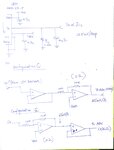pradhan.rachit
Full Member level 3
Hello Experts,
I am designing a circuit where the requirement is to sense bi-directional currents from 0 to 50 Amps mapped from 0 to 5 V.
I have chosen the LEM HAIS 50-P Hall Effect Current Sensor **broken link removed** which offers a sensitivity of 12.5mV/Amp.
To increase the sensitivity to 25mV/A I have an option to either place the gain stage first and then a unity buffer to connect it to the 12-bit ADC of the PIC24F that I'm using.
Or else place the unity buffer first and then amplify the resultant signal to be connected tothe ADC.
Attached are the schematics of the 2 configurations that I'm confused to choose from, and the best possible way to maintain linearity throughout the sensing range.

Kindly suggest which would be the best suitable configuration to avoid any effects of non linearity or impedance mismatch.
I am designing a circuit where the requirement is to sense bi-directional currents from 0 to 50 Amps mapped from 0 to 5 V.
I have chosen the LEM HAIS 50-P Hall Effect Current Sensor **broken link removed** which offers a sensitivity of 12.5mV/Amp.
To increase the sensitivity to 25mV/A I have an option to either place the gain stage first and then a unity buffer to connect it to the 12-bit ADC of the PIC24F that I'm using.
Or else place the unity buffer first and then amplify the resultant signal to be connected tothe ADC.
Attached are the schematics of the 2 configurations that I'm confused to choose from, and the best possible way to maintain linearity throughout the sensing range.

Kindly suggest which would be the best suitable configuration to avoid any effects of non linearity or impedance mismatch.
Last edited:

